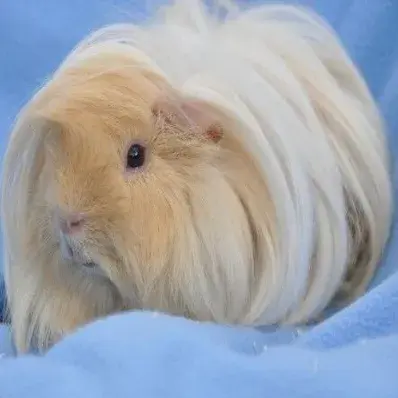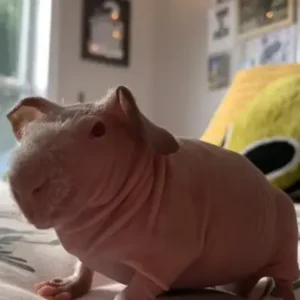Peruvian Guinea Pig Origin
Peruvian guinea pigs are one of the oldest guinea pig breeds out there. They originated from the Andes Mountains in South America.
Earlier, they were famous as a food source, while some tribes also used to worship them as gods. However, their charming personality and cute appearance soon made them a popular pet in France (unlike other breeds), followed by the United States.
Today, they might not be as popular as other mainstream pets but they still can be found with most professional Guinea Pig breeders.
Peruvian Guinea Pig Personality
Peruvian guinea pigs have an active and fun-loving personality. They are curious and love to explore their surroundings. They are also known for their sweet and affectionate nature. They are social animals and enjoy the company of other guinea pigs. They are not suitable for beginners and young children as they require extra care, especially to get them groomed in the right way.
Physical Appearance
Peruvian guinea pigs are long-haired guinea pig breeds that are known for their smooth and long coats. The coats usually grow from the spine of all sides and can even cover their faces. Their hair can grow up to 14 inches or even longer.
- Size
Peruvian Guinea Pigs are considered medium-sized rodents. On average, they typically reach a length of about 8 to 10 inches.
- Coat color
Peruvian guinea pigs come in a variety of colors, including white, black, brown, cream, and mixed.
Gender Differences
Male Peruvian guinea pigs are generally larger than females. However, both genders have a similar temperament and are equally affectionate, so both males and females are equally great pets.
Feed/Nutrition
These delightful pets have specific dietary requirements that you should know:
- Hay: Timothy hay is a staple in a guinea pig’s diet. It provides essential fiber for digestive health. Alfalfa hay can be given in moderation, especially to younger guinea pigs, due to its higher calcium content.
- Fresh Vegetables: Introduce a variety of fresh vegetables daily, such as leafy greens (kale, spinach, and romaine lettuce), bell peppers, and carrots. Rotate vegetables to ensure a diverse nutrient intake.
- Pellets: High-quality guinea pig pellets should make up a portion of their diet. Look for pellets that contain Vitamin C, a crucial nutrient for guinea pigs. Be mindful of portion sizes to prevent overfeeding.
- Fruits: Offer small amounts of fruits as treats, such as apples, strawberries, and blueberries. Limit the intake of fruits high in sugar to prevent obesity.
- Fresh Water: Always provide fresh, clean water. Water bottles are preferable to bowls to prevent spillage and keep water sanitary.
Health
Ensuring the well-being of this South American Guinea Pig involves proactive care, regular check-ups, and a keen awareness of their unique health considerations.
- Parasite Infection: Given their extensive hair, it can be challenging to detect ear infections or mites in Peruvian guinea pigs. Regularly examine their ears for any signs of infection or discomfort. If you observe excessive scratching, head shaking, or redness around the ears, consult with a veterinarian experienced in treating small animals.
- Heatstroke: Heatstroke poses a severe risk to Peruvian guinea pigs, especially in warmer regions and during the summer months. Avoid exposing them to direct sunlight, provide shaded areas in their enclosure, and ensure that water is always available.
- Flystrike: The Peruvian guinea pig’s long hair increases the risk of flystrike. Flystrike is a painful disorder that affects Guinea Pigs. It occurs when flies lay eggs on them. If left untreated, it can be fatal. Regularly inspect your guinea pig for signs of flies or maggots, especially in warmer areas where flystrike is more prevalent.
Care and Grooming
Caring for a Peruvian Guinea Pig involves a combination of attentive care and meticulous grooming. Their luxurious coats require special attention to keep them healthy and vibrant.
Here’s how to ensure your Peruvian Guinea Pig thrives in a nurturing environment:
- Regular Grooming Sessions: Due to their long hair, Peruvian Guinea Pigs require daily grooming to prevent matting and tangling. Aim for at least two grooming sessions per week. Use a soft brush specifically designed for small animals to gently comb through their silky fur, starting from the back and moving toward the head.
- Bathing: While guinea pigs are generally clean animals and don’t require frequent baths, the long hair of Peruvian Guinea Pigs may need occasional washing. Use a mild, guinea pig-safe shampoo and ensure thorough rinsing to remove any soap residue. Dry them completely to prevent chilling.
- Safe and Stimulating Environment: Create a secure and stimulating living environment. Ensure their enclosure is escape-proof and free from hazards. Include tunnels, hideouts, and toys to encourage mental stimulation and physical activity.
- Veterinary Check-ups: Schedule regular check-ups with a veterinarian knowledgeable about small animal care to address any health concerns promptly. Discuss preventive measures for common health issues, including dental care and parasite prevention.
- Avoid Stress: Peruvian Guinea Pigs are sensitive creatures, so minimize stressors in their environment. Handle them gently and provide a calm living space. Introduce changes gradually to avoid causing unnecessary stress.
Rescue Groups
For those looking to provide a loving home to a Peruvian Guinea Pig in need, numerous rescue groups specialize in small animal adoption. You can check these out:
Peruvian Guinea Pig for Sale
Peruvian Guinea Pigs are lovely pets that you can buy from many reputable breeders. You may find these in:
Interesting Facts
- They were believed to bring good luck in ancient South American cultures, and some tribes considered them sacred animals.
- They are known for their long, silky hair that can grow up to 14 inches or even longer.
- These Guinea Pigs are also a delicacy. Peruvian Guinea Pig meat is roasted or deep-fried for special occasions in Peru and other South American countries.
Best For
Peruvian guinea pigs are best for people who are experienced in taking care of guinea pigs. They require extra care, especially when it comes to grooming. They are also social animals and enjoy the company of other guinea pigs.
Top Names
| Male Peruvian Guinea pig Names | Female Peruvian guinea pig Names |
| Oreo | Daisy |
| Gizmo | Luna |
| Peanut | Bella |
| Charlie | Rosie |
| Simba | Ginger |










